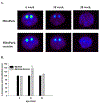Voluntary exercise delays progressive deterioration of markers of metabolism and behavior in a mouse model of Parkinson's disease
- PMID: 31226324
- PMCID: PMC6702069
- DOI: 10.1016/j.brainres.2019.146301
Voluntary exercise delays progressive deterioration of markers of metabolism and behavior in a mouse model of Parkinson's disease
Abstract
Although a good deal is known about the genetics and pathophysiology of Parkinson's disease (PD), and information is emerging about its cause, there are no pharmacological treatments shown to have a significant, sustained capacity to prevent or attenuate the ongoing neurodegenerative processes. However, there is accumulating clinical results to suggest that physical exercise is such a treatment, and studies of animal models of the dopamine (DA) deficiency associated with the motor symptoms of PD further support this hypothesis. Exercise is a non-pharmacological, economically practical, and sustainable intervention with little or no risk and with significant additional health benefits. In this study, we investigated the long-term effects of voluntary exercise on motor behavior and brain biochemistry in the transgenic MitoPark mouse PD model with progressive degeneration of the DA systems caused by DAT-driven deletion of the mitochondrial transcription factor TFAM in DA neurons. We found that voluntary exercise markedly improved behavioral function, including overall motor activity, narrow beam walking, and rotarod performance. There was also improvement of biochemical markers of nigrostriatal DA input. This was manifested by increased levels of DA measured by HPLC, and of the DA membrane transporter measured by PET. Moreover, exercise increased oxygen consumption and, by inference, ATP production via oxidative phosphorylation. Thus, exercise augmented aerobic mitochondrial oxidative metabolism vs glycolysis in the nigrostriatal system. We conclude that there are clear-cut physiological mechanisms for beneficial effects of exercise in PD.
Keywords: Dopamine; Exercise; Mitochondria; PET; Parkinson’s disease.
Copyright © 2019 The Authors. Published by Elsevier B.V. All rights reserved.
Conflict of interest statement
Conflict of Interest and Author Disclosure Statement
LO is a co-owner of a company that owns commercial rights to the MitoPark mouse. The other authors have no conflict of interest.
Figures






Similar articles
-
Intervention with exercise restores motor deficits but not nigrostriatal loss in a progressive MPTP mouse model of Parkinson's disease.Neuroscience. 2015 Jul 23;299:156-74. doi: 10.1016/j.neuroscience.2015.04.069. Epub 2015 May 2. Neuroscience. 2015. PMID: 25943481
-
Exercise in an animal model of Parkinson's disease: Motor recovery but not restoration of the nigrostriatal pathway.Neuroscience. 2017 Sep 17;359:224-247. doi: 10.1016/j.neuroscience.2017.07.031. Epub 2017 Jul 25. Neuroscience. 2017. PMID: 28754312
-
Manganese exposure exacerbates progressive motor deficits and neurodegeneration in the MitoPark mouse model of Parkinson's disease: Relevance to gene and environment interactions in metal neurotoxicity.Neurotoxicology. 2018 Jan;64:240-255. doi: 10.1016/j.neuro.2017.06.002. Epub 2017 Jun 20. Neurotoxicology. 2018. PMID: 28595911 Free PMC article.
-
Unraveling correlative roles of dopamine transporter (DAT) and Parkin in Parkinson's disease (PD) - A road to discovery?Brain Res Bull. 2020 Apr;157:169-179. doi: 10.1016/j.brainresbull.2020.02.001. Epub 2020 Feb 6. Brain Res Bull. 2020. PMID: 32035946 Review.
-
Progressive parkinsonism due to mitochondrial impairment: Lessons from the MitoPark mouse model.Exp Neurol. 2021 Jul;341:113707. doi: 10.1016/j.expneurol.2021.113707. Epub 2021 Mar 20. Exp Neurol. 2021. PMID: 33753138 Free PMC article. Review.
Cited by
-
Sustained Release GLP-1 Agonist PT320 Delays Disease Progression in a Mouse Model of Parkinson's Disease.ACS Pharmacol Transl Sci. 2021 Mar 16;4(2):858-869. doi: 10.1021/acsptsci.1c00013. eCollection 2021 Apr 9. ACS Pharmacol Transl Sci. 2021. PMID: 33860208 Free PMC article.
-
Selecting the Best Animal Model of Parkinson's Disease for Your Research Purpose: Insight from in vivo PET Imaging Studies.Curr Neuropharmacol. 2023;21(5):1241-1272. doi: 10.2174/1570159X21666230216101659. Curr Neuropharmacol. 2023. PMID: 36797611 Free PMC article.
-
Targeting Mitochondrial Impairment in Parkinson's Disease: Challenges and Opportunities.Front Cell Dev Biol. 2021 Jan 5;8:615461. doi: 10.3389/fcell.2020.615461. eCollection 2020. Front Cell Dev Biol. 2021. PMID: 33469539 Free PMC article. Review.
-
Intense exercise increases dopamine transporter and neuromelanin concentrations in the substantia nigra in Parkinson's disease.NPJ Parkinsons Dis. 2024 Feb 9;10(1):34. doi: 10.1038/s41531-024-00641-1. NPJ Parkinsons Dis. 2024. PMID: 38336768 Free PMC article.
-
Probiotics Alleviate the Progressive Deterioration of Motor Functions in a Mouse Model of Parkinson's Disease.Brain Sci. 2020 Apr 1;10(4):206. doi: 10.3390/brainsci10040206. Brain Sci. 2020. PMID: 32244769 Free PMC article.
References
-
- Alonso-Frech F, Sanahuja JJ, and Rodriguez AM (2011). Exercise and physical therapy in early management of Parkinson disease. Neurologist 17, S47–53. - PubMed
-
- Betarbet R, Sherer TB, MacKenzie G, Garcia-Osuna M, Panov AV, and Greenamyre JT (2000). Chronic systemic pesticide exposure reproduces features of Parkinson’s disease. Nat Neurosci 3, 1301–1306. - PubMed
Publication types
MeSH terms
Substances
Grants and funding
LinkOut - more resources
Full Text Sources
Medical
Molecular Biology Databases

